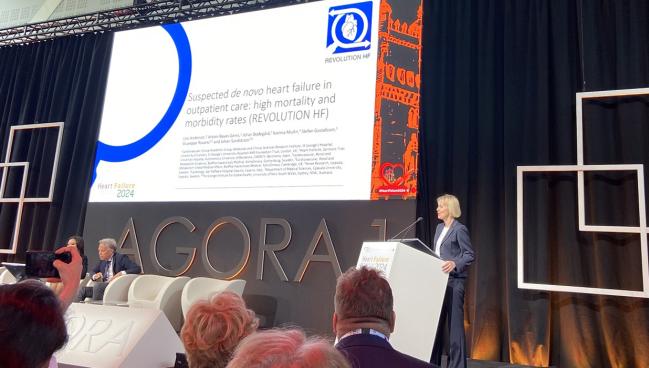Delays to Echo and Diagnosis Spell Poor Early Outcomes in Suspected HF
Even a delay of 2 weeks in those with very elevated NT-proBNP levels leads to HF admissions and deaths in new Swedish study.

LISBON, Portugal—Patients with suspected de novo heart failure (HF) presenting to outpatient centers are not undergoing echocardiography quickly enough to confirm the HF diagnosis, according to new data from the REVOLUTION-HF study presented this past weekend at the European Society of Cardiology (ESC)’s Heart Failure 2024 Congress.
This delay, say researchers, leads to inadequate treatment and high rates of rehospitalization and mortality in the ensuing 12 months.
“The trouble is getting an echo and getting a specialist heart failure person to see the patient,” lead investigator Lisa Anderson, MD (St George’s Healthcare NHS Trust, London, England), told TCTMD. “That's taking too long because there aren't enough technicians, there aren't enough heart failure specialists. So, there’s a big gap—we suspect the patient has heart failure—the NT-proBNP is really high—and yet we just wait and wait and wait. It's during that time period that we're at risk.”
Last year, experts from the Heart Failure Association (HFA) of the ESC proposed an age-adjusted algorithm for the early diagnosis of heart failure using NT-proBNP levels alongside signs and symptoms. Prompt identification, diagnosis, and treatment initiation in patients with de novo HF is needed to reduce the risks of hospital admission and mortality, said Anderson.
In the United Kingdom, it’s recommended that patients with suspected HF and NT-proBNP levels ranging from 400 to 2,000 ng/L get an echocardiogram and be assessed by a HF specialist within 6 weeks of the index presentation. For those with NT-proBNP levels > 2,000 ng/L, that timeline is shortened to 2 weeks.
While experts were initially “quite proud” of the 2- and 6-week diagnostic pathways, Anderson said their new data show that even this is too late for some patients, particularly for those with very high NT-proBNP levels. “I know from my experience that a 2-week appointment is not going to do,” said Anderson. “When it comes to the day of the appointment, you're not surprised when you hear that the patient's already in the hospital.”
Ileana Piña, MD (Thomas Jefferson University, Philadelphia, PA), the discussant following the late-breaking clinical trial presentation, said that while the pillars of guideline-directed medical therapy have been proven effective across multiple randomized, controlled trials, those drugs have been tested in patients with a known HF diagnosis. Physicians seldom see patients as they are developing HF and first symptoms are often attributed to asthma.
We suspect the patient has heart failure—the NT-proBNP is really high—and yet we just wait and wait and wait. Lisa Anderson
“We get rid of a lot of inhalers in clinic because patients, particularly the women, get misdiagnosed with asthma when what they have is heart failure,” said Piña. Other reasons for shortness of breath—older age, lack of fitness—are also used to explain symptoms. “There’s uncertainty, but uncertainty often ends up in the emergency room or with an unscheduled office visit where NT-proBNP might get ordered and there’s a long lineup for an echo.”
Forty Days for Echocardiogram
For the study, known as REVOLUTION-HF, researchers wanted to understand the risk profile of patients with suspected HF. To do so, they turned to Sweden, a country with an extensively linked healthcare system.
Between 2015 and 2020, researchers assessed changes in treatment and clinical events of 5,942 patients presenting to an outpatient clinic with signs (peripheral edema) and/or symptoms (dyspnea) of HF and NT-proBNP levels > 300 ng/L over 1-year of follow-up. These patients were compared with 2,048 matched controls who presented to an outpatient clinic for any reason other than HF.
For those with suspected HF, the mean NT-proBNP levels was 1,543 ng/L, yet just 29% received a formal diagnosis of HF within 12 months after the index presentation. The median time to the first registered echo exam was 40 days.
“Despite this really impressive, almost immediate NT-proBNP testing, the wait to echo and the wait for a formal diagnosis are really disappointing,” said Anderson. Even in the most at-risk cohort—those with NT-proBNP levels > 2,000 ng/L—the time to first echo and a formal HF diagnosis is inadequately slow, she added.
When compared with matched controls, those with suspected HF had higher rates of HF hospitalization (16.1 vs 2.2 events per 100 person-years) and all-cause mortality (10.3 vs 6.5 deaths per 100 person-years). Those events accrued throughout follow-up, but Anderson noted that HF hospitalizations spiked rapidly after the outpatient presentation for those with NT-proBNP levels > 2,000 ng/L.
The data suggest that physicians believed these patients had HF as shown by an immediate fourfold increase in the use of loop diuretics. Despite that, there was a very muted response in the use of guideline-directed medical therapy with beta-blockers, renin-angiotensin-aldosterone system (RAAS) inhibitors, and mineralocorticoid receptor antagonists throughout the 12-month follow-up, said Anderson. Use of SGLT2 inhibitors was very low since they were largely unavailable during the study period.
Risks of Treating While Waiting
Last year’s consensus statement on the use of NT-proBNP levels to help guide management was intended to help physicians move forward confidently in caring for patients with suspected HF, said Anderson. Given the extensive wait times and outcomes, their new data raise questions about how best to medically manage patients with suspected HF. For example, is there an upside to treating these patients almost immediately?
“I think you still do need a definitive echo and assessment,” she said, “but we also need to think that in patients very likely to have heart failure, what are the risks of treating almost blindly while we're waiting? We know we're not going to bring that [delay] down overnight. This is a long-term problem, but we need to be doing something in that gap.”
We get rid of a lot of inhalers in clinic because patients, particularly the women, get misdiagnosed with asthma. Ileana Piña
While many of these patients are elderly with multiple comorbidities, some are already treated with RAAS inhibitors and beta-blockers for other conditions. “There’s quite a lot of background medical therapy,” said Anderson. “The patients were already on some of these drugs. We’re treating them for blood pressure and we think they have heart failure, but we’re just sitting on our hands when [HF] is a much more immediate and dangerous problem.”
For Piña, the high risks of all-cause mortality and HF hospitalization in these patients is “eye-opening” and “disappointing.” Among physicians, she said there’s a misconception that high NT-proBNP levels necessitate use of loop diuretics, but that isn’t correct unless there is volume overload.
“I agree that we need a revolution: a revolution of paying attention to the NT-proBNP,” said Piña. “When you get it and it's elevated, don't think it's just a quirk. Follow it through, get that patient back in there, and start the guideline-directed medical therapy early, don’t wait. The STRONG-HF trial has backed us up on this.”
Michael O’Riordan is the Managing Editor for TCTMD. He completed his undergraduate degrees at Queen’s University in Kingston, ON, and…
Read Full BioSources
Anderson L, on behalf of the REVOLUTION HF investigators. Suspected de novo heart failure in outpatient care: high mortality and morbidity rates. Presented at: ESC Heart Failure 2024. May 11, 2024. Lisbon, Portugal.
Disclosures
- Anderson reports research contracts with Pfizer and speaker’s fees from Pfizer, Vifor, Alnylam. She reports serving on advisory boards for Pharmacosmos, Alnylam, AstraZeneca, and Akcea.
- Piña reports serving on advisory boards for Boehringer Ingelheim and AstraZeneca.





Comments